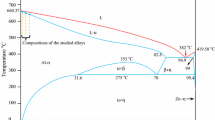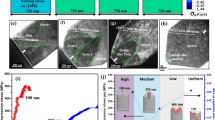Abstract
The growth advantage of twinned dendrites over regular columnar ones was systematically investigated during Bridgman solidification. An experimental approach was designed and the results indicated that the strong twin growth advantage lost its efficiency in the coexisting microstructure containing both twinned and regular dendrites at a low growth rate of 10 μm/s. The twin growth advantage derives from three essential components: the lateral twin propagation perpendicular to twin plane (Rx), the propagation parallel to twin plane (Ry), and the dendrite tip growth (Rz). The lateral extension component Rx played a vital role and would be limited at a low rate. Meanwhile, the tip undercooling of the twinned dendrite was estimated based on its plate-like growth morphology. Furthermore, the competitive growth between twinned dendrites was investigated in different feathery grains. When the included angle between twin planes was relatively large, the lateral twin propagation would keep down the in-plane twin propagation.









Similar content being viewed by others
References
T. Haxhimali, A. Karma, F. Gonzales, and M. Rappaz: Orientation selection in dendritic evolution. Nat. Mater. 5, 660 (2006).
M.A. Salgado-Ordorica and M. Rappaz: Twinned dendrite growth in binary aluminum alloys. Acta Mater. 56, 5708 (2008).
G. Kurtuldu, P. Jarry, and M. Rappaz: Influence of Cr on the nucleation of primary Al and formation of twinned dendrites in Al–Zn–Cr alloys: Can icosahedral solid clusters play a role?Acta Mater. 61, 7098 (2013).
L. Yang, S. Li, X. Chang, H. Zhong, and H. Fu: Twinned dendrite growth during Bridgman solidification. Acta Mater. 97, 269 (2015).
A.K. Srivastava and S. Ranganathan: Microstructural characterization of rapidly solidified Al–Fe–Si, Al–V–Si, and Al–Fe–V–Si alloys. J. Mater. Res. 16, 2103 (2001).
X. Li, Q. Li, Z. Ren, Y. Fautrelle, X. Lu, A. Gagnoud, Y. Zhang, C. Esling, H. Wang, and Y. Dai: Investigation on the formation mechanism of irregular dendrite during directional solidification of Al–Cu alloys under a high magnetic field. J. Alloys Compd. 581, 769 (2013).
A.N. Turchin, M. Zuijderwijk, J. Pool, D.G. Eskin, and L. Katgerman: Feathery grain growth during solidification under forced flow conditions. Acta Mater. 55, 3795 (2007).
S. Henry, P. Jarry, and M. Rappaz: {110} dendrite growth in aluminum feathery grains. Metall. Mater. Trans. A 29A, 2807 (1998).
M.A. Salgado Ordorica: Characterization and Modeling of Twinned Dendrite Growth (Ecole Polytechnique Fédérale de Lausanne, Switzerland, 2009).
L. Yang, S. Li, J. Guo, K. Fan, Y. Li, H. Zhong, and H. Fu: Growth stability of twinned dendrites in directionally solidified Al–4.5 wt% Cu alloy. Mater. Lett. 214, 205 (2017).
S. Henry, G.U. Gruen, and M. Rappaz: Influence of convection on feathery grain formation in aluminum alloys. Metall. Mater. Trans. A 35A, 2495 (2004).
J.A. Eady and L.M. Hogan: Some crystallographic observations of growth-twinned dendrites in aluminum. J. Cryst. Growth 23, 129 (1974).
H.J. Wood, J.D. Hunt, and P.V. Evans: Modelling the growth of feather crystals. Acta Mater. 45, 569 (1997).
M.A. Salgado-Ordorica, P. Burdet, M. Cantoni, and M. Rappaz: Study of the twinned dendrite tip shape II: Experimental assessment. Acta Mater. 59, 5085 (2011).
M.A. Salgado-Ordorica, J.L. Desbiolles, and M. Rappaz: Study of the twinned dendrite tip shape I: Phase-field modeling. Acta Mater. 59, 5074 (2011).
D. Walton and B. Chalmers: The origin of the preferred orientation in the columnar zone of ingots. Trans. Metall. Soc. AIME 215, 447 (1959).
C-A. Gandin and M. Rappaz: A coupled finite element-cellular automaton model for the prediction of dendritic grain structures in solidification processes. Acta Metall. Mater. 42, 2233 (1994).
M. Rappaz and C-A. Gandin: Probabilistic modelling of microstructure formation in solidification processes. Acta Metall. Mater. 41, 345 (1993).
Y. Zhou, A. Volek, and N. Green: Mechanism of competitive grain growth in directional solidification of a nickel-base superalloy. Acta Mater. 56, 2631 (2008).
J. Li, Z. Wang, Y. Wang, and J. Wang: Phase-field study of competitive dendritic growth of converging grains during directional solidification. Acta Mater. 60, 1478 (2012).
K. Han, J. Hirth, and J. Embury: Modeling the formation of twins and stacking faults in the Ag–Cu system. Acta Mater. 49, 1537 (2001).
J. Hirth and R. Pond: Compatibility and accommodation in displacive phase transformations. Prog. Mater. Sci. 56, 586 (2011).
W. Kurz, B. Giovanola, and R. Trivedi: Theory of microstructural development during rapid solidification. Acta Metall. 34, 823 (1986).
W. Kurz and D.J. Fisher: Fundamentals of Solidification, 4th revised ed. (Trans Tech Publication, Switzerland, 1998).
M.A. Salgado-Ordorica, J. Valloton, and M. Rappaz: Study of twinned dendrite growth stability. Scr. Mater. 61, 367 (2009).
M. Aziz: Model for solute redistribution during rapid solidification. J. Appl. Phys. 53, 1158 (1982).
X.B. Meng, Q. Lu, X.L. Zhang, J.G. Li, Z.Q. Chen, Y.H. Wang, Y.Z. Zhou, T. Jin, X.F. Sun, and Z.Q. Hu: Mechanism of competitive growth during directional solidification of a nickel-base superalloy in a three-dimensional reference frame. Acta Mater. 60, 3965 (2012).
S. Gill and W. Kurz: Rapidly solidified Al–Cu alloys—II. Calculation of the microstructure selection map. Acta Metall. Mater. 43, 139 (1995).
ACKNOWLEDGMENTS
The authors are grateful for financial support from the Natural Science Foundation of China (No. 51474174) and the Foundation of State Key Lab of Solidification processing (101-QP-2014 and 133-QP-2015).
Author information
Authors and Affiliations
Corresponding author
Rights and permissions
About this article
Cite this article
Yang, L., Li, S., Li, Y. et al. Study of growth advantage of twinned dendrites in aluminum alloys during Bridgman solidification. Journal of Materials Research 34, 240–250 (2019). https://doi.org/10.1557/jmr.2018.344
Received:
Accepted:
Published:
Issue Date:
DOI: https://doi.org/10.1557/jmr.2018.344




